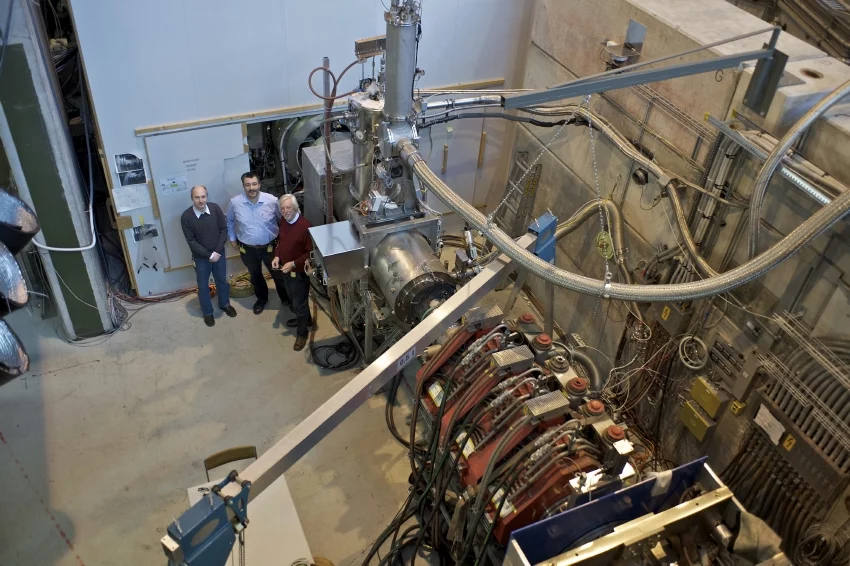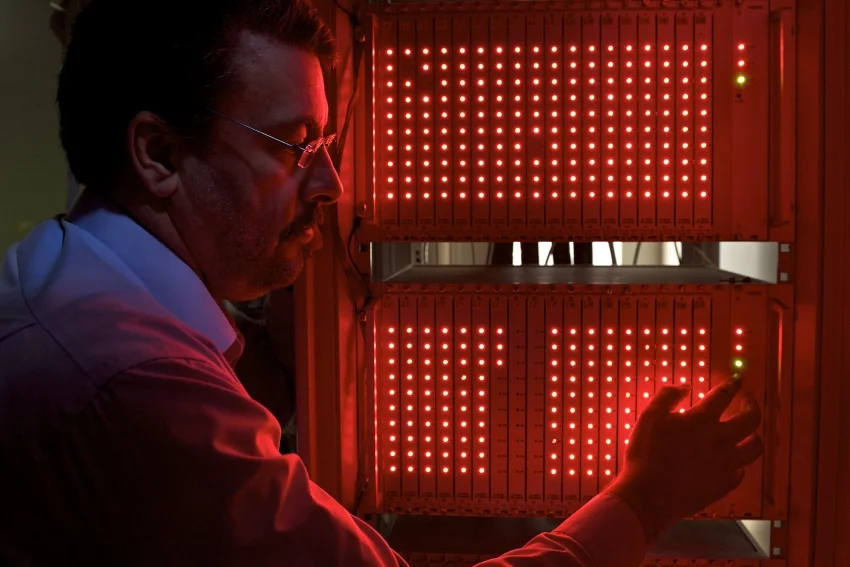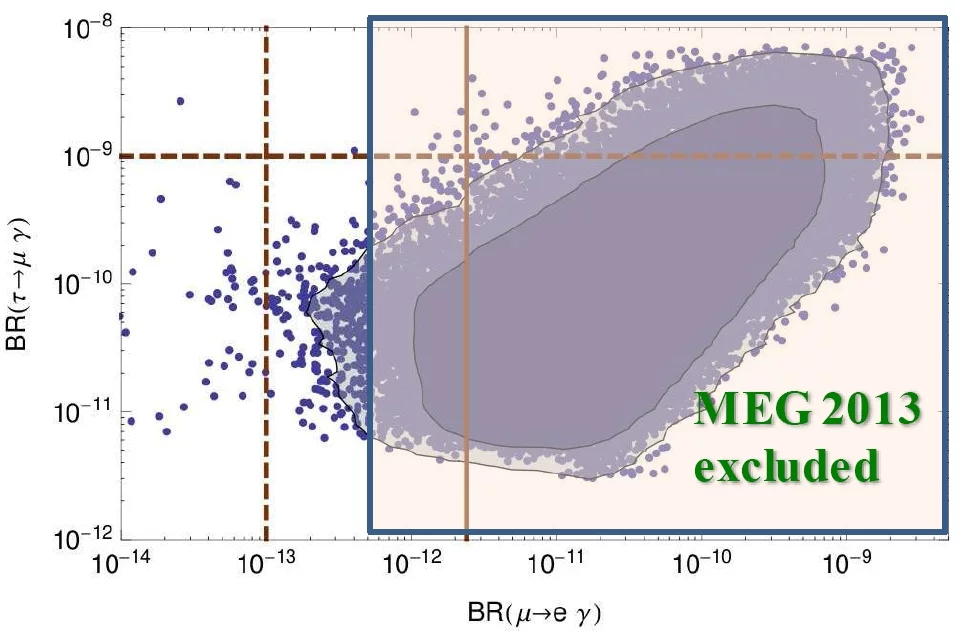A very rare process in nature should best decide on how we should describe our universe in the future. It is the particular decay of a particular type of elementary particle: the muon. These particles are short-lived and decay into a variety of other particles. According to one theoretical model, a very particular decay process is practically forbidden, whereas according to another it should be allowed. Which theory is correct? By observing many hundreds of trillions of muon decays very precisely, physicists at the Paul Scherrer Institut have come a step closer to solving this puzzle. They have now published their results in the journal Physical Review Letters.
The search, by physicists, for one particular type of elementary particle decay is reminiscent of a philosophical consideration: “Although I have seen nothing but black crows in my life,” the young protagonist reflects in Jostein Gaarder’s novel Sophie’s World, “it doesn’t mean that there’s no such thing as a white crow.” Scientists however would probably approach the problem from a somewhat different angle: they would catch one hundred crows. If one of them were white, the probability of finding a white crow would be one per cent. If, however, there was not a single white one amongst the captured birds, they would merely conclude that the probability was less than one per cent. If a thousand black crows were netted, the probability would plummet to less than one tenth of a per cent, motivating the researchers to keep on exploring. They would never completely rule out the existence of the white crow, if it were not seen, but scientifically it would become increasingly more improbable.
The rare decay process – a white crow
The ‘white crow’ the physicists at the Paul Scherrer Institut are searching for is the particular decay process of a tiny particle: the muon. We don’t notice muons in everyday life since they are not part of normal atomic structure as we know it, apart from also decaying into other particles very quickly. However, muons are elementary particles, they belong – together with electrons – to the category of leptons. Just like electrons, they have an electrical charge but differ in that they are 207 times heavier. Consequently, scientists also refer to the muon as the ‘electron’s big brother’.
Such a muon, according to some scientific theories, should decay into an electron and a photon (a light particle), whereas other models, virtually rule out this process: it being supposedly so rare that it would be impossible ever to observe it, as does the Standard Model of particle physics – a comprehensive theory that explains much of what we have been able to observe so far, but unfortunately not everything. The Standard Model does not foresee the existence of so-called dark matter or dark energy: those mysterious phenomena that together are supposed to form around ninety-five per cent of the universe, and only indirectly make their presence felt, but have eluded direct detection so far.
SUSY allows the rare particle decay
As a consequence, one thing seems clear: sooner or later, the Standard Model will need to be extended or even replaced altogether by a new theory. One of the candidates waiting in the wings is SUSY, the theory of Supersymmetry. SUSY is in fact a whole host of models, but quite a number of measurements are still necessary to narrow it down even further. At any rate, according to SUSY this one, contentious rare muon decay should happen with measurable probability. The scientists have no other choice but to comb the world for this rare particle decay, their ‘white crow’. To begin with, they need a lot of crows – a lot of muons, in other words. PSI is predestined for this as nowhere else on Earth do researchers have so many of these particles at their fingertips as here with PSI’s large proton accelerator generating hundreds of millions of muons per second.
Next, the researchers need a suitable net to capture their crows: part of this net is a C-shaped vessel at PSI that is close to three metres high, one metre wide and 0.8 metres deep in size. It can be entered to make modifications, albeit only in protective clothing as everything must remain extremely clean. During the measurements, the container is filled with 900 litres of highly pure liquid xenon. 846 light sensors, so-called photomultipliers, are attached to its walls. If a single light particle hits the xenon atoms in the tank, it triggers a small flash of light sufficient to be registered by the light sensors. Combined with a second measuring device, these sensors can ascertain as to whether the elusive muon decay has actually taken place. The second instrument is a positron detector. Here the researchers have a little trick up their sleeves: instead of looking for a muon decaying into a light particle and an electron, they hunt for the decay of an anti-muon into an anti-electron, called a positron, and a light particle. This occurs just as frequently, but, because of its positive charge, the anti-muon can, decay freely, whereas the negatively charged muon is captured by the atoms of the substance in which it stops and forms a complex structure known as an exotic atom, which decays, in a different way rather than decaying freely as a muon.
How seldom is rare?
Every day, the researchers at PSI measure many trillions of anti-muon decays with their machine and look to see whether only light particles and positrons are among the decay products. After all, it is already clear that the elusive decay is very rare. Though just how rare, however, is what it is all about for the scientists, who are trying to find out whether the Standard Model, SUSY or an entirely different theory best describes our universe. Only at PSI with its copious supply of muons can they pursue this issue so precisely. Ten computers run continuously to cope with this constant deluge of data.
Up to now, however, all the measured light particles and positrons can be explained by other means or decays. Not a single ‘white crow’ in sight – no light particle-positron pair to trace back to the elusive anti-muon decay. Recently, the researchers at PSI have published the data they gathered between 2009 and 2011 in the journal Physical Review Letters. Based on this, the researchers can now say that the probability of this particle decay existing is less than one in 57 trillion.
Down to the wire for SUSY & co.
Does this confirm the Standard Model and eliminate alternative theories such as SUSY? Not entirely, explains Stefan Ritt, the head of the muon research group at PSI’s Laboratory of Particle Physics: the multitude of SUSY model predictions for such rare decay processes, based on varying their model parameters can be depicted as a cloud of dots on a diagram. Based on the measurements Ritt and his colleagues have made, one can draw a line through this diagram that rules out all the dots above it. Thanks to their measurements, which fail to find any of the particle decays sought, this line is measurably being pushed further and further down, thereby eliminating an increasing number of dots.
However, the further the line edges downwards, the greater the effort for the next centimetre. How many more trillions, quadrillions or even quintillions of particle decays do they intend to measure in the hope of catching the tiniest of statistical deviations? “We’ll keep going as long it makes sense,” explains Ritt. With the measurements of the last five years, the scientists have been able to narrow down the confines of SUSY & Co further by a factor of twenty.
The current series of measurements will run until the summer, when operations will be suspended for two years in order to improve the experiment. Among other things, the photomultipliers, which have been round up to now, will be replaced by smaller square detectors as they slot together seamlessly. This will enable even more of the light particle signals to be captured over an even greater area in the xenon tank. “It’s a painstaking and expensive conversion but it will enable us to improve the measurements tenfold,” explains Ritt. For the science community, a factor of ten is a major milestone.
Being a fair referee is better than a Nobel Prize for the experiment
Does Ritt still hope to be able to detect the particle decay – or is his heart so set on the existing Standard Model that he would regret refuting it if he actually found something? “Neither nor,” he immediately answers, “I see myself as a neutral referee by nature. Needless to say, if we discovered the muon gamma decay it would be a sensation; perhaps there would even be a Nobel Prize for it one day. But here it’s about nothing short of the structure of the universe, so we have to take our measurements completely devoid of any bias.” Besides, instead of any emotional preferences for the experimental result, his passion points in a different direction: “I would rather focus on the technical details of the experiment,” he explains.
Incidentally, Sophie’s philosophy lesson goes deeper in the novel: “You might,” her mentor eventually explains, “call the hunt for the white crow science’s most important task of all.” As for muon decay, Stefan Ritt and the other researchers at PSI might well be its most fervent hunters.
International cooperation
The MEG project is an international cooperation. The particiating institutions are:
- From Japan: University of Tokyo, KEK and Waseda University
- From Switzerland: Paul Scherrer Institute
- From Italy: INFN, Pisa, University of Genova, University of Pavia, University La Sapienza, Rome, Univesity of Salento
- From Russia: BINP, Novosibirsk, JINR, Dubna
- From the US: University of California, Irvine
The spokespersons of the collaboration are A. Baldini, INFN Pisa, Italy and T. Mori, University of Tokyo, Japan.
Text: Laura Hennemann
Additional information
Laboratory for Particle Physics at PSI: http://www.psi.ch/ltpContact
Dr. Stefan Ritt, Laboratory for Particle Physics, Paul Scherrer Institute, 5232 Villigen PSI, Switzerland;Phone: +41 56 310 37 28; E-mail: stefan.ritt@psi.ch
Original publication
New Constraint on the Existence of the μ+ → e+ γ DecayJ. Adam et al. (MEG Collaboration)
Phys. Rev. Lett. 110, 201801 (2013)
DOI: 10.1103/PhysRevLett.110.201801



